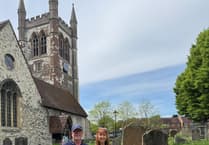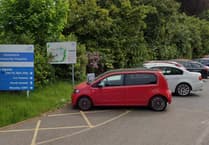IT WAS front page news on May 15, 1957 when demolition work began.
A photograph on Page 1 of the Post’s forerunner, The Hants and Sussex News, was captioned as follows: “With a certain degree of sadness, West Meon villagers are watching the dismantlement of the steel structured railway viaduct on the Petersfield road.
“Once the bridge carried trains over the Gosport-Alton line but some months ago it was sold by the British Transport Commission for scrap. Demolition work is being carried out by Thomas W Ward Ltd, of London.”
This was part of the inglorious end of the 52-year life of the Meon Valley Railway, but which nonetheless played a small part in the history of the Second World War.
The 22.5-mile, single-track railway linked the Mid-Hants line at Butts junction, west of Alton, with the Portsmouth-Eastleigh line at Knowle north of Fareham. Work started in 1898 and was completed by June 1, 1903.
It was promoted by the London and South Western Railway, whose chief engineer William Galbraith was responsible for the design and construction of the track and its bridges, viaduct and tunnels at West Meon and Privett with Relfs, of Plymouth, being the contractor.
Due to ground conditions and steep gradients, the line was difficult to build and a navvy died when part of Privett tunnel collapsed during construction.
The viaduct was 62 feet – 19 metres – above the road. An eight-arch concrete viaduct was planned, but the ground was not as strong as initial tests showed and the four-arch iron design was used instead, with large chalk embankments on the approaches over the unstable ground.
Despite being much lighter than the concrete design, the whole structure weighed over 700 tons and cost £10,000 to build –£692,000 today. The concrete pedestals of the pillars are still visible and it is believed parts of the ironwork are still embedded in the embankments.
The railway company wanted capacity for fast trains and potential for a second track so land was bought to allow for this expansion which never happened.
Stations, designed by Thomas Figgis, were built at Farringdon, Tisted, Privett, West Meon, Droxford and Wickham but passenger numbers were never large except during the two world wars when troops and equipment were moved to and from the coast.
The Meon Valley Railway’s footnote in history came on June 2, 1944.
Winston Churchill, the Prime Ministers of Canada and South Africa and other Allied leaders arrived in a special train at Droxford Station for a meeting at the nearby headquarters of United States General Dwight D Eisenhower, the Supreme Allied Commander, at Southwick House to discuss the final plans for Operation Overlord and the invasion of Europe which led to the end of the war.
The station had the longest siding in southern England, apart from the railway works at Eastleigh, and was close to a deep cutting. If threatened by an air raid, the train could have been pushed into the relative safety of the cutting.




